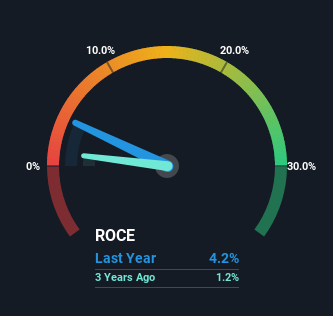- Germany
- /
- Electric Utilities
- /
- XTRA:EBK
The Returns At EnBW Energie Baden-Württemberg (ETR:EBK) Aren't Growing
Did you know there are some financial metrics that can provide clues of a potential multi-bagger? Firstly, we'll want to see a proven return on capital employed (ROCE) that is increasing, and secondly, an expanding base of capital employed. This shows us that it's a compounding machine, able to continually reinvest its earnings back into the business and generate higher returns. Although, when we looked at EnBW Energie Baden-Württemberg (ETR:EBK), it didn't seem to tick all of these boxes.
Return On Capital Employed (ROCE): What Is It?
For those who don't know, ROCE is a measure of a company's yearly pre-tax profit (its return), relative to the capital employed in the business. The formula for this calculation on EnBW Energie Baden-Württemberg is:
Return on Capital Employed = Earnings Before Interest and Tax (EBIT) ÷ (Total Assets - Current Liabilities)
0.042 = €1.8b ÷ (€88b - €45b) (Based on the trailing twelve months to September 2022).
Therefore, EnBW Energie Baden-Württemberg has an ROCE of 4.2%. Ultimately, that's a low return and it under-performs the Electric Utilities industry average of 8.4%.
See our latest analysis for EnBW Energie Baden-Württemberg

Historical performance is a great place to start when researching a stock so above you can see the gauge for EnBW Energie Baden-Württemberg's ROCE against it's prior returns. If you'd like to look at how EnBW Energie Baden-Württemberg has performed in the past in other metrics, you can view this free graph of past earnings, revenue and cash flow.
How Are Returns Trending?
There are better returns on capital out there than what we're seeing at EnBW Energie Baden-Württemberg. The company has employed 52% more capital in the last five years, and the returns on that capital have remained stable at 4.2%. Given the company has increased the amount of capital employed, it appears the investments that have been made simply don't provide a high return on capital.
On another note, while the change in ROCE trend might not scream for attention, it's interesting that the current liabilities have actually gone up over the last five years. This is intriguing because if current liabilities hadn't increased to 51% of total assets, this reported ROCE would probably be less than4.2% because total capital employed would be higher.The 4.2% ROCE could be even lower if current liabilities weren't 51% of total assets, because the the formula would show a larger base of total capital employed. So with current liabilities at such high levels, this effectively means the likes of suppliers or short-term creditors are funding a meaningful part of the business, which in some instances can bring some risks.
The Key Takeaway
Long story short, while EnBW Energie Baden-Württemberg has been reinvesting its capital, the returns that it's generating haven't increased. Yet to long term shareholders the stock has gifted them an incredible 235% return in the last five years, so the market appears to be rosy about its future. However, unless these underlying trends turn more positive, we wouldn't get our hopes up too high.
EnBW Energie Baden-Württemberg does come with some risks though, we found 3 warning signs in our investment analysis, and 1 of those shouldn't be ignored...
While EnBW Energie Baden-Württemberg isn't earning the highest return, check out this free list of companies that are earning high returns on equity with solid balance sheets.
Valuation is complex, but we're here to simplify it.
Discover if EnBW Energie Baden-Württemberg might be undervalued or overvalued with our detailed analysis, featuring fair value estimates, potential risks, dividends, insider trades, and its financial condition.
Access Free AnalysisHave feedback on this article? Concerned about the content? Get in touch with us directly. Alternatively, email editorial-team (at) simplywallst.com.
This article by Simply Wall St is general in nature. We provide commentary based on historical data and analyst forecasts only using an unbiased methodology and our articles are not intended to be financial advice. It does not constitute a recommendation to buy or sell any stock, and does not take account of your objectives, or your financial situation. We aim to bring you long-term focused analysis driven by fundamental data. Note that our analysis may not factor in the latest price-sensitive company announcements or qualitative material. Simply Wall St has no position in any stocks mentioned.
About XTRA:EBK
EnBW Energie Baden-Württemberg
Operates as an integrated energy company in Germany, Rest of Europe, and internationally.
Slight risk with acceptable track record.
Similar Companies
Market Insights
Community Narratives



